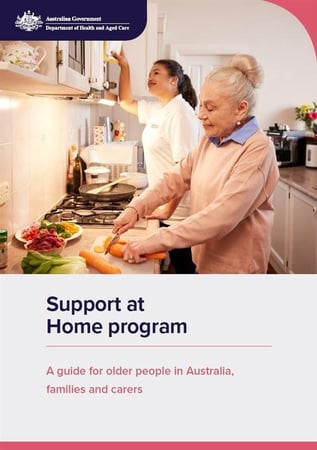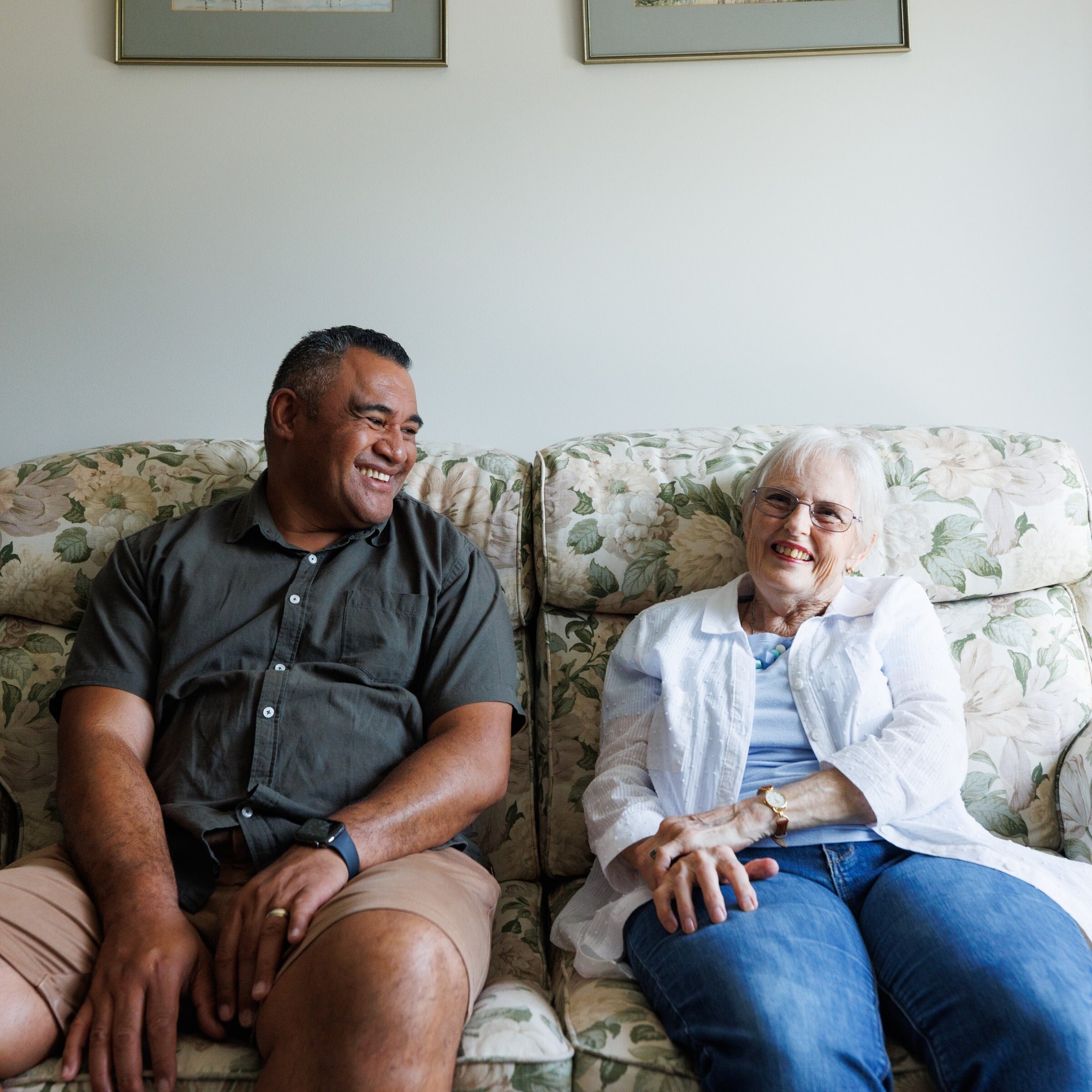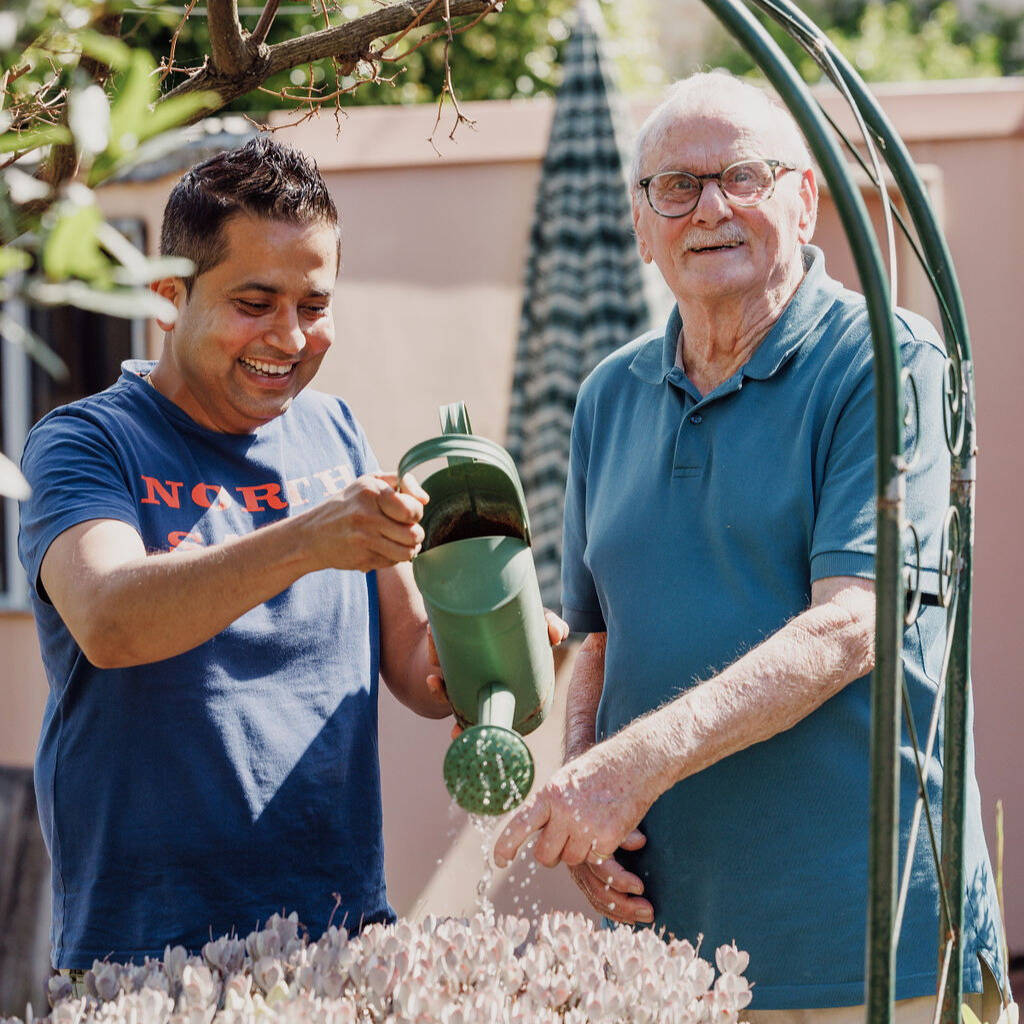Support at Home
Information about Australia’s new home care program
The Government's Support at Home program commenced on 1 November 2025, bringing together and replacing some existing in-home programs, including Home Care Packages. This resource collection will help you understand the changes and how they may apply to you.
What is Support at Home?
Support at Home is the new government framework that details how all home care providers must deliver services. It is a completely new system, purpose-built by the Australian Government to align with the new Aged Care Act 2024 and Strengthened Quality Standards.
The program commenced on 1 November 2025 with a new funding and fee structure. It replaces Home Care Packages and the Short-Term Restorative Care Programme. The Commonwealth Home Support Programme will transition across, but not before 1 July 2027.

Support at Home program – overview for older people
This short video from the Australian Department of Health, Disability and Ageing provides a helpful overview of Support at Home.
Key features of Support at Home
The Government has designed Support at Home as a simpler and more equitable aged care system for older people living at home.
- 8 main funding levels, with up to $78,000 for high care needs
- Annual budgets managed in quarterly amounts
- New funding pathways for short-term supports
- Defined list of services, split into 3 categories
- New fee structure, with management fees capped at 10%
What services are available under Support at Home?
Support at Home services are divided into 3 categories, as listed below. You can read the full service list on the Government website.
Clinical Supports

Clinical Supports
Specialised services to help you maintain or regain functional and/or cognitive capabilities.
- Nursing care
- Allied health and other therapeutic services
- Nutrition
- Care management
- Restorative care management
Independence Supports

Independence Supports
Support to help you manage the loss of skills required to live independently, and help with activities of daily living.
- Personal care
- Social support and community engagement
- Therapeutic care services
- Respite care
- Transport
- Assistance technology and home modifications
Everyday Living

Everyday Living
Support to help you keep your home in a liveable state so you can stay living independently for as long as possible.
- House cleaning
- Laundry
- Assistance with shopping
- Gardening
- Minor repairs
- Meal preparation
Clinical Supports
Specialised services to help you maintain or regain functional and/or cognitive capabilities.
- Nursing care
- Allied health and other therapeutic services
- Nutrition
- Care management
- Restorative care management

Independence Supports
Support to help you manage the loss of skills required to live independently, and help with activities of daily living.
- Personal care
- Social support and community engagement
- Therapeutic care services
- Respite care
- Transport
- Assistance technology and home modifications

Everyday Living
Support to help you keep your home in a liveable state so you can stay living independently for as long as possible.
- House cleaning
- Laundry
- Assistance with shopping
- Gardening
- Minor repairs
- Meal preparation

Additional short-term supports
The Support at Home program introduces three new funding pathways for specific, short-term needs: the Restorative Care Pathway, the End-of-Life Care Pathway, and the Assistive Technology and Home Modifications scheme.
Restorative Care Pathway
The Restorative Care Pathway can help you stay independent, reduce the need for more services and support you in doing the activities you enjoy. It provides access to up to 12 weeks of restorative care support services. This funding pathway can be accessed over and above your base level Support at Home budget.
End-of-Life Pathway
The End-of-Life Pathway supports individuals to remain at home in their last 3 months of life by urgently providing extra funding for a higher-level of in-home care and services. This funding pathway can be accessed instead of your base level Support at Home budget.
Assistive Technology and Home Modifications scheme
The Assistive Technology and Home Modifications (AT-HM) scheme funds products and services that support your safety, accessibility and independence. This funding is additional to the main Support at Home budget, alleviating the need to save for more support.
How much funding is available?
Eligible participants may access funding of $500 to $15,000 for assistive technology like mobility equipment, bathing devices and toileting supports.
A separate budget of $500 to $15,000 may be available for home modifications that make your home safer and more accessible.

Support at Home levels and budgets
Support at Home has 8 main levels and corresponding budgets for ongoing services. These funding amounts include funding for care management.
*Figures are indicative, based on the Government website. View the full list of subsidies and supplements calculated at daily rates.
Level |
Quarterly budget* |
Annual amount* |
|---|---|---|
| Support at Home 1 | $2,682.75 | $10,731.00 |
| Support at Home 2 | $4,008.61 | $16,034.45 |
| Support at Home 3 | $5,491.43 | $21,965.70 |
| Support at Home 4 | $7,424.10 | $29,696.40 |
| Support at Home 5 | $9,924.35 | $39,697.40 |
| Support at Home 6 | $12,028.58 | $48,114.30 |
| Support at Home 7 | $14,537.04 | $58,148.15 |
| Support at Home 8 | $19,526.59 | $78,106.35 |
If you are already receiving a Home Care Package on 1 November 2025, or if you are approved for a Home Care Package before 1 November but your funding is assigned after this date, you will receive a transitional level of funding equivalent to your approved Home Care Package level.
Level |
Quarterly budget* |
Annual amount* |
|---|---|---|
| Transitioned HCP Level 1 | $2,746.63 | $10,986.50 |
| Transitioned HCP Level 2 | $4,829.86 | $19,319.45 |
| Transitioned HCP Level 3 | $10,513.83 | $42,055.30 |
| Transitioned HCP Level 4 | $15,939.55 | $63,758.20 |
Support at Home contributions
Support at Home has been designed as a "pay for what you use" system. That means you'll contribute to the cost of certain services, if you're assessed as having the means to do so. A lifetime cap applies, so the amount you contribute is limited. If you move into residential care, this cap travels with you.
Are you a full pensioner?
According to the Government's participant contribution framework, you will contribute*:
- Clinical supports: 0%
- Independence services: 5%
- Everyday living services: 17.5%
What you contribute will depend on your assessed income and assets as determined by Services Australia in the lead up to 1 November.
*Do you currently have a home care package, or approval for funding?
Grandfathering or transitional conditions may apply to you - see below for details.
Are you a part pensioner?
According to the Government's participant contribution framework, you will contribute*:
- Clinical supports: 0%
- Independence services: between 5% and 50%
- Everyday living services: between 17.5% and 80%
What you contribute will depend on your assessed income and assets as determined by Services Australia in the lead up to 1 November.
*Do you currently have a home care package, or approval for funding?
Grandfathering or transitional conditions may apply to you - see below for details.
Are you a self-funded retiree?
According to the Government's participant contribution framework, you will contribute*:
- Clinical supports: 0%
- Independence services: 50%
- Everyday living services: 80%
What you contribute will depend on your assessed income and assets as determined by Services Australia in the lead up to 1 November.
*Do you currently have a home care package, or approval for funding?
Grandfathering or transitional conditions may apply to you - see below for details.
Do you already have a home care package?
If you are a current home care client, or have home care package approval prior to 1 November 2025, certain provisions will apply to you under Support at Home.
Approved on or before
12 Sep 2024
When were you approved for a Home Care Package?
On or before 12 Sep 2024
Grandfathering and transitional arrangements apply to you.
- You can access all ongoing service types on the new Support at Home service list.
- You will transition to Support at Home with a transitional package and will receive an equivalent amount of funding to your current approved Home Care Package.
- You can be reassessed for more funding under Support at Home if your needs change.
- Your lifetime contribution cap will remain at $82,018.
- You are eligible for the Government's no worse off principle which guarantees that your financial contribution will be the same or less than what you currently pay.
- If you are not currently required to pay an income tested care fee, then your contribution rate for all services will be 0%.
Approved between
12 Sep 2024 - 30 Jun 2025
When were you approved for a Home Care Package?
After 12 Sep 2024
Transitional arrangements apply to you.
- You can access all ongoing service types on the new Support at Home service list.
- You will transition to Support at Home with a transitional package and will receive an equivalent amount of funding to your current approved Home Care Package.
- You can be reassessed for more funding under Support at Home if your needs change.
- Your lifetime contribution cap will be set at $130,000.
- You are not eligible for the Government's no worse off principle, which means the new Support at Home contribution rates (as assigned by Services Australia) will apply to you.
- Even if you are not currently required to pay an income tested care fee, you will be required to contribute for Independence and Everyday Living services.
Got unspent funds?
When were you approved for a Home Care Package?
Using your unspent funds
If you are an existing home care package client, any unspent funds will transition with you to Support at Home.
There's no time limit on using the unspent funds you've accrued as part of your home care package.
But you will need to use your unspent funds before using any funds approved under the new Assistive Technology and Home Modifications scheme.
Going forward, your Support at Home budget will be managed quarterly and any new unspent funds accrued after 1 November 2025 will be capped.
If you don't spend your entire quarterly budget, you will be able to roll over 10% or $1000 of your quarterly budget (whichever is greater) to the following quarter.
What else do I need to know about Support at Home?
Why is the home care system changing and what is the new Aged Care Act?
The law for government-funded aged care in Australia is being updated to improve the way services are delivered to older people.
The current law (the Aged Care Act 1997), which underpins existing aged care programs including Home Care Packages, was found no longer fit for purpose by the Royal Commission into Aged Care. This is because it is structured around providers and how to fund them, rather than around the people accessing services and what they need.
The new law (the Aged Care Act 2024) starts from 1 November 2025 and aligns with the launch of the new Support at Home program. It puts the rights of older people at the centre of the aged care system to make care safer, fairer, and more respectful. Learn more by watching the Government video about your aged care rights.
What will change with Support at Home?
Under the new Support at Home program, older people will have better access to services, products, equipment, and home modifications that support their health, independence, and social connection within the community.
Support at Home will have a defined service list across three categories: clinical care, independence support, and everyday living assistance. There will also be dedicated support for short-term needs, and higher funding options for people who need it most.
The program will have a new fee and funding structure.
I have a Home Care Package. Do I have to go onto Support at Home?
The Home Care Packages Program will come to an end on 31 October 2025. If you currently have a Home Care Package, the Government will automatically transition you to equivalent funding under the Support at Home Program on 1 November. We will work in partnership with you to put in place a new Support at Home Service Agreement. We are waiting for further details to be confirmed by the Government to determine how Support at Home will apply to each person, including their financial arrangements.
How is HammondCare preparing for Support at Home?
HammondCare has appointed a dedicated team of people to manage all aspects of the transition to Support at Home. A key priority is ensuring updates are provided about any changes, including clarifying what those changes mean for each person, as soon as the details are made available.
Will I have to pay contributions?
If you were approved for a Home Care Package on or before 12 September 2024, you qualify for the Government's no worse off principle. That means you won't contribute any more than you are currently required to under the Home Care Package program (so if you aren't required to contribute anything now, you won't be required to contribute under Support at Home). If you were approved for a Home Care Package after 12 September 2024, the new Support at Home contribution rates will apply to you.
Contribution rates are assigned by Services Australia and are set according to your assessed means. Contributions only apply to services in the Independence and Everyday Living categories. Clinical care services will be fully funded by the Government for everyone.
What if I can't afford to pay my contributions?
What’s next for Support at Home?
The Government sent letters to home care clients about Support at Home.
If you have questions, HammondCare can support you by responding with the details that are currently available or guiding you to the relevant Government resources that have been provided.
The linked documents on this page provide the most up to date information about Support at Home.
Other resources for Support at Home
We recommend viewing the resources provided by the Department of Health, Disability and Ageing.
- Frequently asked questions from older people, families and carers about the Support at Home program
- Upcoming community information sessions
- Support at Home program booklet for older people, families and carers
- Helpful video and explainer to understand your aged care rights
- New Aged Care Act resources for older people, their families and carers
- List of Support at Home services
- List of assistive technologies and home modifications
- Open letter to older people about the deferral of Support at Home
- Subscribe to aged care newsletters and alerts
For more help, you can also contact My Aged Care on 1800 200 422.
Information about the Aged Care Reforms
If you're receiving aged care services from 1 November 2025, there are new frameworks and policies in place to protect your rights as a consumer.
- The new Statement of Rights video and explainer
- The new Aged Care Code of Conduct
- The new Whistleblowing policy
- A new Registered Supporter role
Under this new program, we’ll have the same mission of care
The Government continues to release transition details for the new Support at Home program, and the home care sector including HammondCare is monitoring for updates in the lead up to 1 November.
Throughout this process, we will continue to help you understand what the changes mean for you, while remaining committed to providing the best possible care.

Our friendly HammondCare Support team are ready to chat, 24/7
Whether you’re ready to start building your home care team, or just want to learn more about how home care works, we're here to help. Send us a message by filling in the form, or call us anytime on 1800 998 111.
Interested in working with us? Apply for roles here.

